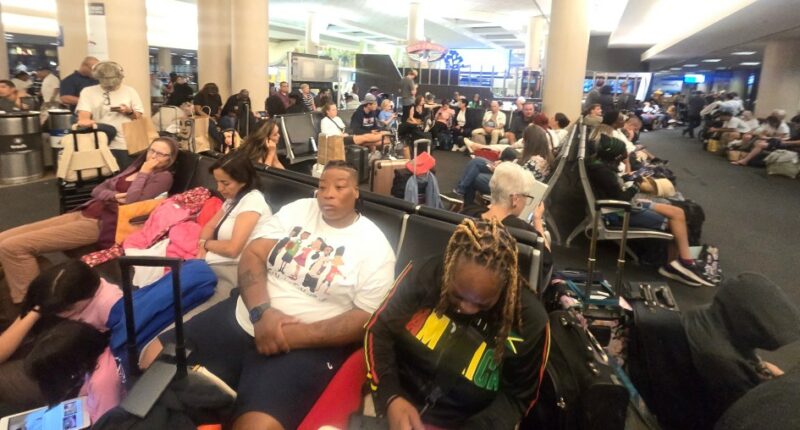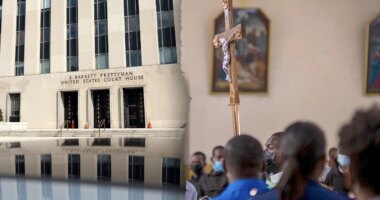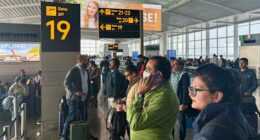Share this @internewscast.com
The 8.8 magnitude earthquake near Russia has caused airlines to halt flights and some aircraft to reroute, leading to significant travel disruptions.
Numerous travelers bound for Hawaii are stuck in airport departure lounges, awaiting the possible arrival of tsunami waves expected to affect the island.
Hawaii is bracing for waves as high as potentially 10 foot after the 8.8 magnitude quake struck off Russia.
The quake hit about 84 miles off the coast at around 7.24pm EST on Tuesday (12:30am BST) at a shallow depth of 19.3km (12 miles).
It is the 6th largest-ever quake recorded and the largest since the 2011 shake which led to a tsunami that caused the Fukushima nuclear disaster.
Pictures show scores of travelers waiting for updates in Los Angeles International Airport.
Departure lounges were packed as Americans heading to Honolulu were met with the message their American Airlines flight had been delayed.
And, Alaska and Hawaiian are among the carriers that have paused flights.
Some passenger planes en-route to Hawaii have been forced to divert.
Travelers are asking Alaska Airlines if flights to Hawaii will be canceled in light of the tsunami warning.
Meanwhile, bosses at Hawaiian have issued a travel waiver to all impacted passengers.
Those who are traveling between July 29 and 30 can reschedule their flight and they will not be charged.
Alternatively, passengers can cancel their flights and will be given credit, which can be used toward a new plane ticket.
What causes tsunamis?
Here are the facts…
- Tsunami is a Japanese word used to describe huge waves – generally on oceans, but sometimes in lakes or large rivers
- Ocean tsunamis are caused by sudden motions, which displace a large amount of water
- This is typically an earthquake, but it could also be a volcanic eruption or underwater landslide
- A huge impact into water – like a large landslide or meteor – can also cause tsunamis
- When an earthquake happens, huge tectonic plates crunch together
- When the “snap” eventually happens, this gives a large shove to water
- This creates a tsunami that travels very quickly across the open oceans
- As the ocean becomes shallower, the tsunami wave is forced upwards
- This means tsunami waves typically grow very quickly in height (and slow down) as they approach the shallow shorelines near land
- Tsunamis are typically a series of waves, rather than one single wave
- As they approach land, these waves get closer together
- One of the best ways to spot an incoming tsunami is a sudden retreat of coastal water
- If the tide goes out very quickly, it’s a telling sign that something is wrong
- What you’re actually seeing is the trough of the incoming tsunami wave – on a huge scale
- The initial tsunami impact can be deadly
- But tsunami flooding is also highly dangerous to life, damaging buildings, destroying infrastructure, spreading waste and disease, and drowning people
Travelers have been urged to check the status of their flights before they head to the airport.
Tsunami waves are hitting Hawaii and locals have been ordered to take urgent action.
One wave over five foot has been reported in Kahului, while a four foot wave struck Haleiwa, which is located on the north shore of Oahu.
Josh Green, the Hawaii governor, said six feet high waves hit Midway Atoll – located between Japan and Hawaii.
He warned waves hitting Hawaii could be bigger or smaller and said there is a risk that cars and fences could be thrown about.
“It can dislodge trees, that’s why you cant just be out there,” he said.
“The impact is at great speed.
“Any any structure that gets loose and strikes the individual could take them out.
“And people can drown quite easily with the force of that kind of wave.”
Green said Hawaii had not yet seen a “wave of consequence.”
Approximately 200 individuals are taking refuge in Maui airport, with all flights in and out of the airport being canceled. Additionally, millions were alerted to the tsunami threat through notifications on their mobile devices.
“You are in danger,” the notice said.
“Get away from coastal waters. Move to high ground or inland now.
“Keep away from the coast until local officials say it is safe to return.”
All commercial harbors on the island have been closed as a precaution.
Roads in Waikiki, Oahu are backed up with cars as residents try to head to higher ground.
Cars clogged up roads in Honolulu as drivers headed toward the mountains.
Areas of northern California have been put under a tsunami warning.
Crescent City, a village with 6,700 people, is expected to be the worst hit.
Tsunami warning sirens blared throughout the village on Tuesday night.
Crescent City was badly hit in 1964 when a 9.2-magnitude earthquake struck Alaska.
The majority of the California is under a tsunami advisory.
Meanwhile, waves in the Russian Pacific town of Severo-Kurilsk exceeded 16 feet.
The impact of the waves saw beluga whales washed up, prompting locals to throw water over the animals to try and save them.
Waves between one and three feet could hit Chile, Costa Rica, and Peru.






















